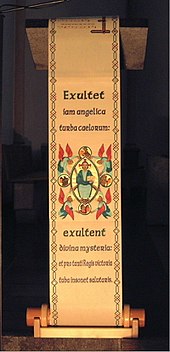Exultet role
Exsultet rolls are scrolls that were created in the Middle Ages and contain the text and melody of Exsultet (historical spelling "Exultet").
origin
The exsultet scrolls from southern Italy were created between the 10th and 13th centuries, the Codex Vat. Lat. 9820 , which was probably created in Benevento between 985 and 987. The scrolls were written and illustrated in Benedictine monasteries, especially in Montecassino . Actually, they are anachronistic phenomena, because since the end of the 4th century books were no longer produced on rolls but as codices . The Codex was found to be more practical in many ways and better suited to conveying cultural heritage in written form. In contrast to the Torah scrolls, Exsultet scrolls are not rolled out from right to left, but from top to bottom from the ambo . These roles can therefore be recorded as a unit. In contrast to the Codex, they offer an increased possibility of arrangement, a theologically thought-out emphasis on before and after. Pictures illustrate the text of the Exsultet. Some extensions such as B. Scenes from the life of Jesus or even nativity scenes in praise of the bee clearly point to the influence of the theology of the Church Fathers. In many roles, the images are upside down so that the believers can look at the images in the right direction when the scroll is unrolled while the chant is being performed.
Text and melody
The roles of southern Italy know two different versions of the Easter praise: the Gallican and the Beneventan. Texts and melodies are sometimes very different from each other.
Use in the liturgy
The solemnity of the Easter Vigil liturgy is enhanced by the use of such a role. But one must not overlook the practical purpose either. The splendid architecture of the ambones of the churches in Rome and southern Italy invites you to use such splendid pieces. Each role is a highly independent work, but common, especially Byzantine influences are recognizable. In terms of art history and palaeography, these roles have already been extensively examined, but in theological terms they have received little attention up to now.
Exultet roles today
Today, individual rolls are made on elephant skin paper with printed text and notation, but painted by hand in the Mariendonk Abbey (Lower Rhine) in this tradition.
literature
- Guglielmo Cavallo : Exultet, rotoli liturgici del medioevo meridionale. Libreria dello Stato - Istituto Poligrafico e Zecca dello Stato, Rome 1994, ISBN 88-240-0338-9 .
- Guglielmo Cavallo: Exultet. In: Enciclopedia dell'Arte Medievale. Rome 1995 ( online at treccani.it ).
- Thomas Forrest Kelly: The Exultet in Southern Italy. Oxford University Press, New York NY et al. 1996, ISBN 0-19-509527-8 .
- Clara Vasseur: Rediscovering the old. The rich symbolism of the Easter candle. Media combination. Beuroner Kunstverlag, Beuron 2007, ISBN 978-3-87071-160-3 .
Web links
- Exultic roles. In: The large art dictionary by PW Hartmann.
- Hanno-Walter Kruft: Exsultetrolls. In: Real Lexicon on German Art History. Volume 6: Donkey Back - Color, Colorants. Beck, Munich 1971, pp. 719-740.

